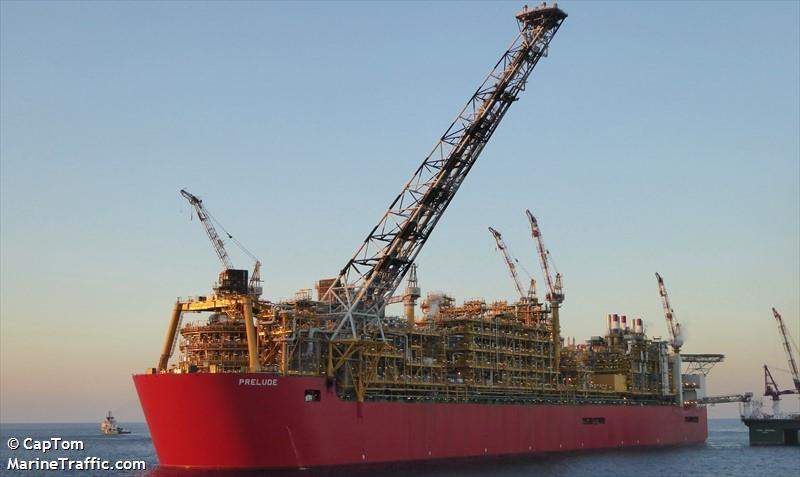
Global Giants Revolutionizing Biggest LNG Tankers Transportation
Biggest FLNG tankers: Hilli Episeyo
Once the Hilli LNG carrier built in 1975, the Hilli Episeyo is the world’s first converted vessel on the list of biggest FLNG tankers, located offshore Cameroon in the Gulf of Guinea. It was constructed by Singaporean offshore company Keppel for an estimated conversion cost of $1.2bn and is currently operated by Golar LNG.
Hilli Episeyo FLNG is 294m in length with a storage capacity of 125,000m3, and was to designed to produce around 2.4 million tonnes per annum (mtpa) of LNG. The converted FLNG first left the shipyard in Singapore in October 2017, arriving in Cameroon in late November. It was then connected to the Sanaga offshore gas field, which was the first offshore gas field to be developed in Cameroon to feed the 216MW Kribi Power Plant.
The FLNG has been used to test the PRICO LNG technology developed by engineering company Black & Veatch. Golar LNG CEO Iain Ross said in a press release: “The crew are becoming increasingly comfortable with the facility, which has achieved 100% commercial availability to date. Lessons learned during the conversion, commissioning and from operations to date will be invaluable for the next FLNG project, which is also expected to utilise the same Black & Veatch technology.”
Biggest FLNG tankers: Fortuna
Another Golar LNG conversion, the Fortuna FLNG was once the Gandria LNG tanker. Its prospective length upon completion is said to be 357m and the conversion project will cost approximately $1.5bn, with an additional $0.6bn in upstream costs. Chinese investors will reportedly finance around $1.2bn of the total cost.
Compared to the Hilli Episeyo FLNG, the Fortuna FLNG will be better equipped for harsher conditions in open waters, according to LNG World Shipping.
The Fortuna FLNG prospect will have a storage capacity of around 230,000m3 and will produce approximately 3mpta of LNG over a 20-year period from the Fortuna gas field offshore Equatorial Guinea.
Fortuna FLNG will liquefy natural gas onboard and transport it to LNG carriers. Golar’s Ross told Reuters that the first LNG is expected to be produced by the end of 2021. He also noted two or three ‘strong’ FLNG prospects that have emerged following the success of the Hilli Episeyo facility.
“We’re seeing Hilli’s proof of concept triggering new interest…We think this is a truly disruptive solution in an industry not known for its disruptive solutions,” Ross said.
Biggest FLNG tankers: Petronas
Petronas’ FLNG, known as PFLNG Satu, is a 365m-long LNG tanker, currently stationed between Malaysia and Indonesia in the Riau Archipelago. In April 2017, PFLNG Satu became the first completed FLNG vessel to produce LNG from the Kanowit gas field offshore Malaysia.
The vessel is said to cost approximately $10bn and produces 1.2mtpa of LNG. PFLNG Satu has a storage capacity of 354,000m3, and displaces more than 600,000t of water at full load. It is designed to last up to 20 years without the need for dry-docking and can be redeployed in different locations.
Oversupply in the LNG market has resulted in the Asian spot price for LNG falling by 70% since 2014, when prices peaked to 5.5 million British thermal units (mmbtu).
At the time of the facility’s launch, Wood Mackenzie senior upstream analyst Prasanth Kakaraparth told Reuters: “Petronas enters a super-elite club of global players with FLNG capability. But with spot prices looking to trend below $5/mmbtu, this is a very tough environment to be bringing on new supply.”
Biggest FLNG tankers: Coral South
Coral South is a prospective FLNG project led by Italian energy giant Eni, which will be located at the Coral South gas field in area four of the Rovuma basin offshore Mozambique. The gas field is known to contain 450 billion cubic metres of gas alone. In March 2017, Eni signed a sale and purchase agreement with ExxonMobil for the latter to acquire a 25% stake in area four.
At 430m long, this FLNG is expected to produce around 3.4mtpa of LNG over 25 years. The cost of the FLNG is around $4.7bn, after a financing agreement was approved by the company.
Coral South FLNG is the first project sanctioned in area four by Eni and its development partners.
Eni CEO Claudio Descalzi said in a press release: “As the world transitions to a low-carbon energy mix, Eni believes that the use of gas is critical to achieving a more sustainable future. Our ambition to become a global integrated gas and LNG player is based on working alongside key partners such as Mozambique.
“The Coral South project will deliver a reliable source of energy while contributing to Mozambique’s economic development. This partnership approach with our hosting countries is the foundation on which our joint sustainable growth strategy is built.”
Biggest FLNG tankers: Prelude
At 488m long and 74m wide, Shell’s Prelude FLNG is the world’s largest FLNG vessel and the biggest offshore facility. To get a clearer picture of the size, the ship’s deck is longer than four football pitches and its storage tanks can hold the equivalent of 175 Olympic sized swimming pools, or 437,500m3 of liquid.
Shell has said the Prelude FLNG, which is currently based in the Browse Basin off the coast of Western Australia, will harvest a minimum of 3.6mtpa of LNG, 1.3mtpa of natural gas condensate, and 0.4mtpa of liquefied petroleum gas.
This would be enough gas to cover the annual needs of Hong Kong with a population of 7.4 million people, according to the company.
At full load, the Prelude FLNG displaces 600,000t of water and although the cost of the vessel remains undisclosed, industry analysts told Reuters its price tag was around $10.8bn to $12.6bn in total.
After testing in June this year, Shell has predicted that production from the enormous vessel will begin later this year. The Prelude will stay in its current location for 20-25 years.



